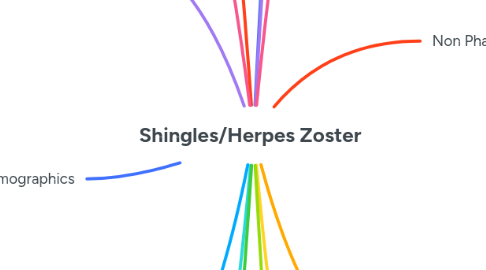
1. Patho/Etiology
1.1. Viral infection caused by the varicella-zoster virus (VZV). After an individual recovers from chickenpox, the virus remains dormant in the nerve tissues and can reactivate years later, causing shingles (Nair & Patel, 2023).
1.1.1. The dermatological involvement follows a dermatome. Most cases involve the lumbar and cervical roots (Nair & Patel, 2023).
1.1.2. The dermatone involved for the OSCE patient was most likely the Lumbar (L1-L5) based on the distrubution of her rash and back pain.
1.2. Reactivation of latent varicella-zoster virus in ganglia (Nair & Patel, 2023).
1.3. Virus replicated in neuronal cell bodies and are carried down the nerve (Nair & Patel, 2023).
2. Causative Factor
2.1. Several factors can contribute to the reactivation of varicella-zoster virus
2.1.1. Weakening of the immune system
2.1.1.1. Medications that suppress the immune system such as corticosteriods or immunosuppressive drugs
2.1.1.2. Stress, HIV/AIDS, Cancer
2.1.2. Advanced Age (>50 years old)
2.1.3. History of chickenpox
2.2. Varicella-zoster virus exposure (Rare)
3. Risk Factors
3.1. >50 years of age
3.2. Female Sex
3.3. HIV
3.4. Chronic Corticosteriod use
3.5. Chemotherapy
4. Demographics
4.1. >50 years of age
4.2. Shingles can affect all demographics. However, research suggests that it is less common among Black Americans (Marra et al., 2020).
4.3. Immunocomprimised Individuals
5. Clinical Manifestations
5.1. Shingles usually begins with pain, tingling, or itching in a specific area of the body. Often described as burning, stabbing, or shooting sensation.
5.2. Within a few days of the initial pain, a blistering red rash develops in the affected area.
5.2.1. Fluid-filled blisters
5.2.2. Skin Lesions
5.3. Other symptoms may include fever, headache, fatigue, sensitivity to light, and malaise
6. Physical Exam Findings
6.1. Presence of a red, blistering rash eruption that follows a dermatomal distrubution
6.1.1. Often clustered/grouped together and localized to one side of the body or face
6.2. Presence of vesicles and ulcers
6.3. Redness and Inflammation around the rash
6.4. Pain or tenderness with light palpation/touch
6.5. Regional Lymphadenopathy (some cases)
7. Preventitive Measures
7.1. Shingles Vaccines
7.1.1. Recombinant Zoster Vaccine
7.1.1.1. Shingrix is the preferred shingles vaccine for adults >50 years. It is 90% effective (Izurieta et al., 2021).
7.1.2. Live Virus Vaccine
7.1.2.1. Zostavax can be used if the patient is allergic to Shingrix or prefers it. However, it is much less effective when compared to Shingrix (Sun et al., 2021).
8. Differnential Diagnoses
8.1. Herpes simplex, Contact dermatitis, dermatitis herpetiformis, impetigo, candidiasis, insect bite (Nair & Patel, 2023).
9. Diagnostic Tests
9.1. Clinical Diagnosis
9.2. Polymerase chain reaction (PCR)
9.3. Immunohistochemistry, vesicular fluid culture, HIV test
10. Pharm
10.1. Oral Antiviral Therapy (Primary Options)
10.1.1. valacyclovir 1000 mg orally every 8 hours for 7 days
10.1.1.1. Would have prescribed Valacyclovir for the OSCE Patient
10.1.1.2. Should start within 48 to 72 hours of rash onset
10.1.1.3. Can be used up to 10 days in patients with eye manifestations
10.1.1.4. In comparison to famiciclovir, valacyclovir is more effective in managaing Herpes Zoster
10.1.2. famiciclovir 500 mg every 8 hours for 7 days
10.2. Mild Pain
10.2.1. acetaminophen 325 mg orally every 4-6 hours PRN for pain
10.2.2. lidocaine patch can be used once vesicles are crusted
10.3. Moderate/Severe Pain
10.3.1. Oxycodone 5 mg orally (immediate-release) every 4-6 hours PRN for pain
10.3.1.1. Would have prescribed Oxycodone for the OSCE Patient
10.4. Corticosteroids
10.4.1. Prednisone 5 mg orally 5 times a day for two weeks
10.4.1.1. The use of corticosteriods may improve infllammatory factors, reduce nerve injury (Peng et al., 2019).
11. Non Pharm
11.1. Calamine lotion can be used after the blisters have crusted over to relieve itchy skin
11.2. Oatmeal bath
11.3. Keep rash clean and dry to reduce the risk of bacterial superinfection
11.4. Burrow's solution 5% aluminum subacetate can help relieve discomfort and promote crusting
11.5. Damp/Cool Washcloth
12. Patient Education
12.1. Avoid pregnant women, children under 1 years old, and unvaccinated individuals
12.2. Individual with varicella is contagious 1-2 days before rash onset
12.3. Some vaccinated individuals can become infected and develop lesions that do not crust
12.4. Possible complication of postherpetic pain
13. Potentional Complications
13.1. Herpes Zoster ophthalmicus
13.1.1. Cranial Nerve V, can result in corneal blindless. Refer to ophthalmologist or ED immediately (Lo et al., 2018).
13.2. Postherpetic neuralgia
13.2.1. Monitor for burning, aching, and severe pain in the areas where the shingles rash initially occured. This pain could last months to years (Nair & Patel, 2023).
13.3. Bacterial Superinfection
13.3.1. Cellulitis, osteomyelitis, necrotizing fascitis, and sepsis (Rare)
13.4. Ramsay Hunt Syndrome/HZ oticus
13.4.1. Example: Justin Bieber 2022
13.4.2. Triad of ipsilateral facial paralysis, ear pain, vesicles in the ear canal and auricle (Goswami & Gaurkar, 2023).
14. Referrals
14.1. Refer to ophthalmologist is required for patients with eye involvement (Goswami & Bandyopadhyay, 2021).
14.1.1. 50% to 90% of cases involve ocular complications (Nair & Patel, 2023).
14.2. Refer to pain management specialist if the pain interferes with ADLs
14.2.1. Some patients may develop postherpetic pain and would requires help to manage chronic pain
